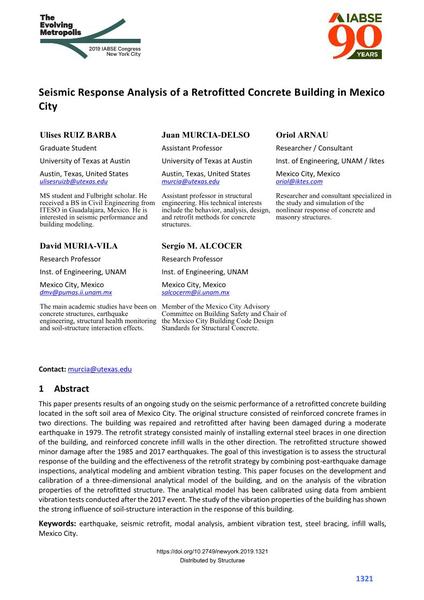Seismic Response Analysis of a Retrofitted Concrete Building in Mexico City

|
|
|||||||||||
Détails bibliographiques
| Auteur(s): |
Ulises Ruiz Barba
(University of Texas at Austin)
Juan Murcia-Delso (University of Texas at Austin) Oriol Arnau (Inst. of Engineering, UNAM; Iktes) David Muria-Vila (Inst. of Engineering, UNAM) Sergio M. Alcocer (Inst. of Engineering, UNAM) |
||||
|---|---|---|---|---|---|
| Médium: | papier de conférence | ||||
| Langue(s): | anglais | ||||
| Conférence: | IABSE Congress: The Evolving Metropolis, New York, NY, USA, 4-6 September 2019 | ||||
| Publié dans: | The Evolving Metropolis | ||||
|
|||||
| Page(s): | 1321-1327 | ||||
| Nombre total de pages (du PDF): | 7 | ||||
| DOI: | 10.2749/newyork.2019.1321 | ||||
| Abstrait: |
This paper presents results of an ongoing study on the seismic performance of a retrofitted concrete building located in the soft soil area of Mexico City. The original structure consisted of reinforced concrete frames in two directions. The building was repaired and retrofitted after having been damaged during a moderate earthquake in 1979. The retrofit strategy consisted mainly of installing external steel braces in one direction of the building, and reinforced concrete infill walls in the other direction. The retrofitted structure showed minor damage after the 1985 and 2017 earthquakes. The goal of this investigation is to assess the structural response of the building and the effectiveness of the retrofit strategy by combining post-earthquake damage inspections, analytical modeling and ambient vibration testing. This paper focuses on the development and calibration of a three-dimensional analytical model of the building, and on the analysis of the vibration properties of the retrofitted structure. The analytical model has been calibrated using data from ambient vibration tests conducted after the 2017 event. The study of the vibration properties of the building has shown the strong influence of soil-structure interaction in the response of this building. |
||||
| Mots-clé: |
tremblement de terre reconception pour effets sismiques
|
||||

